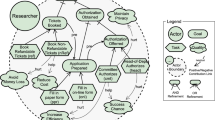Abstract
Business strategies aim to operationalize an enterprise’s mission and visions by defining initiatives and choosing among alternative courses of action through some form of strategic analysis. However, existing analysis techniques (e.g., SWOT analysis, Five Forces Model) are invariably informal and sketchy, in sharp contrast to the formal and algorithmic counterparts developed in Conceptual Modeling and Software Engineering. Among such techniques, goal models and goal reasoning have become very prominent over the past twenty years, helping to model stakeholder requirements and the alternative ways these can be fulfilled. In this work we explore the applicability of goal models to conceptualize strategic business problems and capture viable alternatives in support of formal strategic decision-making. We show through a comparative study how analysis can be conducted on a realistic case adopted from the literature using existing goal modeling techniques, and identify their weaknesses and limitations that need to be addressed in order to accommodate strategic business analysis.
Access this chapter
Tax calculation will be finalised at checkout
Purchases are for personal use only
Similar content being viewed by others
Notes
- 1.
Find the complete model at http://disi.unitn.it/~paja/pdf/rccl-diagrams.pdf.
- 2.
See http://disi.unitn.it/~paja/pdf/rccl-diagrams.pdf for the complete model.
References
Amyot, D., Ghanavati, S., Horkoff, J., Mussbacher, G., Peyton, L., Yu, E.: Evaluating goal models within the goal-oriented requirement language. In: IJIS (2010)
Blythe, J.: Principles & Practice of Marketing. Cengage Learning EMEA, Boston (2006)
Carroll, P., Mui, C., Lessons, B.D.: What You Can Learn from the Most Inexcusable Business Failures of the Last Twenty-five Years. Penguin, New York (2008)
Dardenne, A., van Lamsweerde, A., Fickas, S.: Goal-directed requirements acquisition. Sci. Comput. Program. 20(1–2), 3–50 (1993)
Dealtry, R.: ‘Dynamic SWOT Analysis’: Developer’s Guide. IP (1992)
Eisenhardt, K.M., Zbaracki, M.J.: Strategic decision making. SMJ 13, 17 (1992)
Greco, S.: Multiple Criteria Decision Analysis: State of the Art Surveys, vol. 78. Springer Science & Business Media, New York (2005)
Giorgini, P., Mylopoulos, J., Sebastiani, R.: Goal-oriented requirements analysis and reasoning in the tropos methodology. EAAI 18(2), 159–171 (2005)
Handfield, R., Walton, S.V., Sroufe, R., Melnyk, S.A.: Applying environmental criteria to supplier assessment: a study in the application of the analytical hierarchy process. Eur. J. Oper. Res. 141(1), 70–87 (2002)
Horkoff, J., Barone, D., Jiang, L., Yu, E., Amyot, D., Borgida, A., Mylopoulos, J.: Strategic business modeling: representation and reasoning. SSM 13, 1015–1041 (2014)
Horkoff, J., Yu, E.: Analyzing goal models: different approaches and how to choose among them. In: ACM SAC, pp. 675–682. ACM (2011)
Horkoff, J., Yu, E.: Comparison and evaluation of goal-oriented satisfaction analysis techniques. REJ 18(3), 199–222 (2013)
Horkoff, J., Yu, E.: Interactive goal model analysis for early requirements engineering. In: REJ, pp. 1–33 (2014)
Kaplan, R.S., Norton, D.P.: Putting the balanced scorecard to work. Performance measurement, management, and appraisal sourcebook, vol. 66 (1995)
Kaplan, R.S., Norton, D.P.: Strategy Maps: Converting Intangible Assets into Tangible Outcomes. Harvard Business Press, Boston (2004)
Letier, E., Stefan, D., Barr, E.T.: Uncertainty, risk, and information value in software requirements and architecture. In: ICSE, pp. 883–894. ACM (2014)
Liaskos, S., McIlraith, S.A., Sohrabi, S., Mylopoulos, J.: Integrating preferences into goal models for requirements engineering. In: RE, pp. 135–144 (2010)
McFarlan, F.W., Massoni, V.: Royal Caribbean Cruises Ltd. HBS (2003)
Object Management Group. Business Motivation Model v1.3 specification (2015)
Porter, M.E.: Competitive Strategy: Techniques for Analyzing Industries and Competition, vol. 300. Free Press, New York (1980)
Porter, M.E.: The five competitive forces that shape strategy (2008)
Robinson, R.: Economic evaluation and health care: cost-benefit analysis. Br. Med. J. 307, 924–924 (1993)
Shyur, H.J., Sh Shih, H.: A hybrid MCDM model for strategic vendor selection. Math. Comput. Model. 44(7), 749–761 (2006)
van Lamsweerde, A.: Goal-oriented requirements engineering: a guided tour. In: ISRE, pp. 249–263 (2001)
Yu, E.: Towards modelling and reasoning support for early-phase requirements engineering. In: ISRE, pp. 226–235. IEEE (1997)
Acknowledgements
This research was partially supported by the ERC advanced grant 267856, ‘Lucretius: Foundations for Software Evolution’, www.lucretius.eu. A. Maté is funded by Generalitat Valenciana (APOSTD/2014/064).
Author information
Authors and Affiliations
Corresponding author
Editor information
Editors and Affiliations
Rights and permissions
Copyright information
© 2016 Springer International Publishing AG
About this paper
Cite this paper
Paja, E., Maté, A., Woo, C., Mylopoulos, J. (2016). Can Goal Reasoning Techniques Be Used for Strategic Decision-Making?. In: Comyn-Wattiau, I., Tanaka, K., Song, IY., Yamamoto, S., Saeki, M. (eds) Conceptual Modeling. ER 2016. Lecture Notes in Computer Science(), vol 9974. Springer, Cham. https://doi.org/10.1007/978-3-319-46397-1_41
Download citation
DOI: https://doi.org/10.1007/978-3-319-46397-1_41
Published:
Publisher Name: Springer, Cham
Print ISBN: 978-3-319-46396-4
Online ISBN: 978-3-319-46397-1
eBook Packages: Computer ScienceComputer Science (R0)




